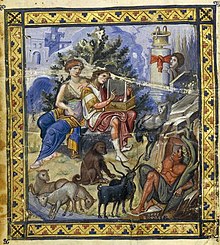Paris Psalter
The Paris Psalter (also Codex Parisianus, Bibliothèque Nationale, Paris, MS gr. 139) is an illuminated Byzantine manuscript with 449 folia and 14 full-page miniatures from the middle of the 10th century. The splendid manuscript is one of the main documents of antique book illumination from the time of the Macedonian Renaissance in Byzantine art .
history
The Paris Psalter belongs to the so-called “aristocratic group” of Byzantine psalteries, which differ from the “monastic” psalteries with only marginal miniatures in their full pictures. Most experts of the 19th century dated the miniatures of the Paris Psalter to the time of Justinian I , as they are clearly in the Hellenistic tradition in their execution and were in contrast to the general opinion of the Byzantine art of the Middle Ages. However, the Byzantists Hugo Buchthal and Kurt Weitzmann have conclusively proven that the Paris Psalter was created in the 10th century. The manuscript is in the Bibliothèque nationale de France in Paris .
description
The codex has a width of 37 cm and a height of 26.5 cm. The most famous miniature shows David playing the harp next to an allegory of the melody (fol. 1 v ). David sits in a splendid short robe, in a natural and free pose in front of the viewer. Leaning just as casually on his shoulder, the melody embodies the sensual grace of antiquity . The peplos has slipped off her left shoulder, revealing the breast of beauty, the shapes of which represent the ideal of the perfect body. Various wild animals are grouped around this pair, listening to David's music, as well as the Oreade Echo and a male figure who symbolizes the city of Bethlehem . The model for this depiction was probably a Greco-Roman wall painting from the 3rd or 4th century, which showed the singer Orpheus , who bewitched the whole world with the magic of his music.
The unknown illuminator (s) made extensive use of the allegory as a stylistic device. In addition to the melody on the first sheet, fol. 2 v a female allegorical figure of power on the side of David, who is fighting the lion and on fol. 3 v a likewise female personification of gentleness in unction by David Samuel (fol. 3 v ). The erotic depiction of gentleness proves that this precious handwriting was less used for liturgical purposes than for the demonstration of demonstrative enjoyment of life and the private representation of the high-ranking client. On fol. 419 v accompany personifications of the night, the desert , the abyss and the Red Sea Moses at the crossing of the Red Sea . ( Ex 14.21 EU )
The influence of Hellenistic art, whether in the selection of the figures ( nymphs and allegories) or in their execution, is evident on most of the sheets. An example is fol. 435 v . On this full-page miniature, night and dawn - depicted as the child Orthros - allegorically surround the prophet Isaiah . The Nyx is holding a cloth studded with silver stars over her head and in her left hand is a lowered torch. Since she embodies the night, both her face and her clothes are colored blue-gray. Their representation also follows the Hellenistic conventions. A hand in the clouds forms the Christ monogram Chi and Rho , the first two letters of the Greek word Christ , as a sign of blessing. The miniature is the illustration of the prophecy of an eschatological savior by Isaiah - at the end of the night and at the beginning of a new morning or at the end of one age and the beginning of a new age. The corresponding Bible passage reads: “The people who live in darkness see a bright light; a light shines on those who dwell in the land of darkness. "( Isa 9,1 EU )
literature
- Kurt Weitzmann: The Paris Psalter ms. gr. 139 and the Middle Byzantine Renaissance , In: Jahrbuch für Kunstwissenschaft 6, Marburg 1929.
- Kurt Weitzmann: The Byzantine book illumination of the 9th and 10th centuries. Archaeological Institute of the German Empire, Dept. Istanbul, Verlag Gebr. Mann Berlin 1935.
- Kurt Weitzmann: Spiritual foundations and essence of the Macedonian Renaissance. Working Group for Research of the State of North Rhine-Westphalia 107, Westdeutscher Verlag, Cologne 1963.
- Hugo Buchthal: The Miniatures of the Paris Psalter. A Study in Middle Byzantine Painting. Warburg Institute, London 1938, reprint 1968.
- Hugo Buchthal: The Exaltation of David . In: Journal of the Warburg and Courtauld Institutes 37, 1974.
- Ingo F. Walther, N. Wolf: Codices Illustres. The most beautiful illuminated manuscripts in the world 400 to 1600. Taschen Verlag, Cologne 2005. ISBN 3-8228-4747-X
Web links
- Digitized "Psautier de Paris" , at bnf.fr
Individual evidence
- ↑ Moïse recevant les Tables de la Loi, Psautier de Paris Le Projet Utpictura18 (French)
- ↑ The figure is not labeled, its identification with Echo results only from the analogy to the myth of Orpheus and Eurydice
- ^ 2001 yearbook of the Bibliotheca Hertziana. ( Memento from January 9, 2011 in the Internet Archive ) (PDF; 497 kB) Max Planck Institute, Rome 2001

